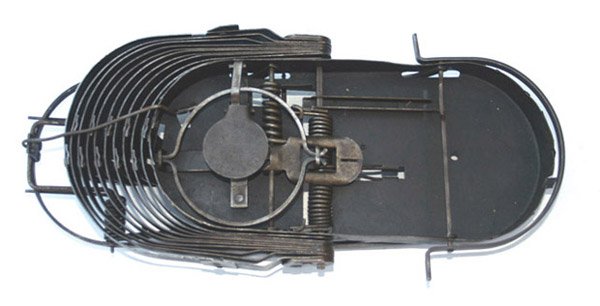 Antique Traps: Gibbs Live Muskrat Trap
Antique Traps: Gibbs Live Muskrat Trap 
By Tom Parr

Before making traps, W.A. Gibbs surveyed, developed and managed electrical railways in the United States and Canada. When he retired in 1913, he bought a marsh on Maryland’s famous Eastern Shore to serve as a duck hunting preserve. But the marsh was overrun with muskrats, and it was not long before the businessman in Gibbs saw the commercial possibilities. The engineer in him attacked the problem in predictable fashion, and in the process, Gibbs started a second career as a trap manufacturer that would last another 20 years.
Gibbs was a very inventive man. In fact, he patented 16 different trap designs including the No. 111, the Two Trigger, the Hawk trap, the Dope trap, and the Single Grip. He also patented an apparatus for deboning fish, a device for anchoring a live duck decoy, and a fur stretcher.
By 1925, there was a growing market for live muskrats to restock depleted marshes. Being ever the inventor, and having a marsh overrun with muskrats to test his designs, W.A. Gibbs began developing a live muskrat trap. The finished device looked very much like an armadillo, with a retractable dome that automatically deployed to enclose the live muskrat inside. This ingenious device also had a platform that held a No. 1 size coilspring trap and a set of legs that raised the platform out of the water about 4 inches.
When a muskrat was caught in the coilspring trap, automatically and at a precise moment, the dome unrolled over the platform, the coilspring trap released its grip on the muskrat’s leg, and the live, unharmed muskrat was then elevated safely out of the water.
A man who worked at the Gibbs marsh described setting several of the traps, each having a carbide torch somehow attached to the triggering device. The man waited in a small shanty in the marsh, and whenever a light appeared, he went out, retrieved the live muskrat, and reset the trap. This allowed multiple catches with each trap.
The Live Catch Muskrat Trap was produced in at least two versions, one having a slide bar attachment to accommodate a stake and the other basically the same but without the stake holder. A tool was supplied to help in setting the small trap and to activate the dome.
The complicated trap was only on the market three or four years. In 1930, Gibbs brought out a simpler live-catch muskrat trap called the Live Net Trap.
The Gibbs armadillo trap is prized by collectors for both its rarity and ingenious design. One in very good condition will bring $1,200 or more.

***
For more on collectible traps, contact:
Tom Parr, the North American Trap
Collectors Association, P.O. Box 94,
Galloway, OH 43119; (614) 878-6011.